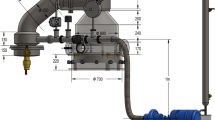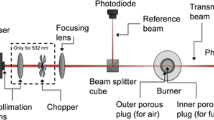Abstract
The structural change in co-flow propylene diffusion flames by irradiation of laser light is experimentally investigated to examine the effect of soot radiation at a certain position. The soot volume fraction and the flame/soot temperatures are measured by laser extinction and two-color-ratio pyrometry techniques. Transitions from a non-sooting to a sooting flame and vice versa are observed to depend on the irradiated positions of laser light. The structural change could be attributed to the following processes. When laser light is irradiated at the soot-formation region (lower part in the flame), the temperature of soot particles is increased by absorption of laser energy; the raised temperature enhances soot formation and increases the local volume fraction of soot. The increased amount of soot enhances the radiation loss and eventually lowers the flame temperature at the downstream direction. As a result, the soot-oxidation process is suppressed, and finally a non-sooting flame transforms to a sooting flame. The laser light irradiated at the competing section of soot formation and oxidation or at the oxidation section (upper part of the flame) also increases the temperature of soot particles, however, the increased soot temperature mostly enhances soot oxidation in these regions. Therefore, a decreased amount of soot lowers the radiation loss from the flame and maintains the flame temperature relatively high, compared with that without irradiation of laser light. As a result, the soot-oxidation process is more enhanced, and finally the transition from a sooting flame to a non-sooting flame occurs.
Similar content being viewed by others
References
M. A. Delichatsios, J. D. Ris, and L. Orloff, “An enhanced flame radiation burner, Proc. Combust. Inst., 24, 1075–1082 (1992).
I. M. Kennedy, “Models of soot formation and oxidation,” Progr. Energ. Combust. Sci., 23, 95–132 (1997).
I. M. Kennedy, C. Yam, D. C. Rapp, and R. J. Santoro, “Modeling and measurements of soot and species in a laminar diffusion flame,” Combust. Flame, 107, 368–382 (1996).
A. V. Krestinin, “Detailed modeling of soot formation in hydrocarbon pyrolysis,” Combust. Flame, 121, 513–524 (2000).
A. D’Alessio, A. D’Anna, A. D’Orsi, et al., “Precursors formation and soot inception in premixed ethylene flames,” Proc. Combust. Inst., 24, 973–980 (1992).
R. A. Dobbins, “Soot inception temperature and carbonization rate of precursor particles,” Combust. Flame, 130, 204–214 (2002).
K. C. Oh, U. D. Lee, E. J. Lee, and H. D. Shin, “The evolution of incipient soot particles in ethane inverse diffusion flame,” Combust. Flame, 140, 249–254 (2005).
M. D. Smooke, C. S. Mcenally, and L. D. Pfefferle, “Computational and experimental study of soot formation in a coflow laminar diffusion flame,” Combust. Flame, 117, 117–139 (1999).
C. S. Mcenally, A. M. Schaffer, M. B. Long, et al., “Computational and experimental study of soot formation in a coflow laminar ethylene diffusion flame,” Proc. Combust. Inst., 27, 1497–1505 (1998).
F. Liu, H. Guo, G. J. Smallwood, and O. L. Gulder, “Effects of gas and soot radiation on soot formation in a coflow laminar ethylene diffusion flame,” J. Quant. Spectrosc. Radiat., 73, 409–421 (2002).
W. Lee, “The effect of pressure on PAH and soot formation at elevated pressure,” J. KSME, B (in Korean), 22, No. 10, 1445–1453 (1998).
W. Lee and Y. D. Na, “Soot study in laminar diffusion flames at elevated pressure using two-color pyrometry and Abel inversion,” in: 4th JSME-KSME Thermal Engineering Conf., Kobe, Japan (2000).
C. J. Dasch, “One-dimensional tomography: A comparison of Abel, onion-peeling, and filtered back projection methods,” Appl. Optics, 31, 1146–1152 (1992).
Author information
Authors and Affiliations
Additional information
__________
Translated from Fizika Goreniya i Vzryva, Vol. 42, No. 6, pp. 74–81, November–December, 2006.
Rights and permissions
About this article
Cite this article
Lee, C.B., Lee, W., Oh, K.C. et al. Sooting and non-sooting propylene diffusion flames with irradiation of laser light. Combust Explos Shock Waves 42, 688–695 (2006). https://doi.org/10.1007/s10573-006-0102-y
Received:
Issue Date:
DOI: https://doi.org/10.1007/s10573-006-0102-y




